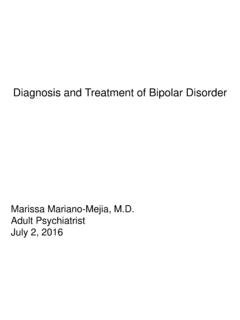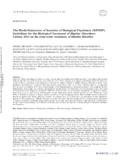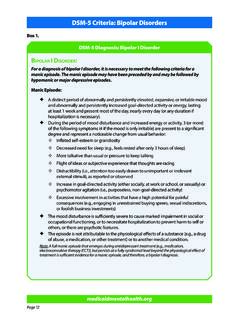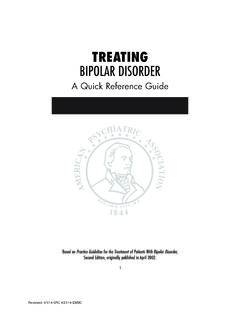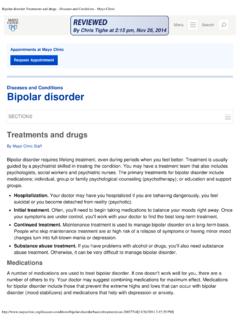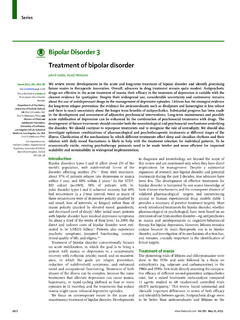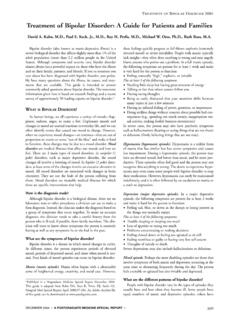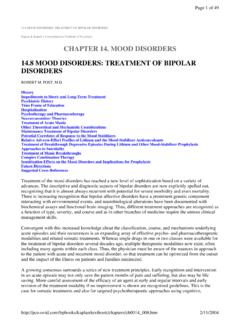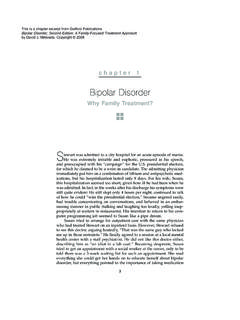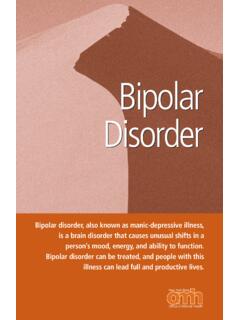Transcription of Treatment Guidelines for Children and Adolescents With ...
1 JOBNAME: chi 44#3 2005 PAGE: 1 OUTPUT: Wed January 26 18:11:39 2005. lww/chi/90680/CHI57088. Prod#: CHI57088. SPECIAL COMMUNICATION. Treatment Guidelines for Children and Adolescents With bipolar Disorder: Child Psychiatric Workgroup on bipolar Disorder ROBERT A. KOWATCH, , MARY FRISTAD, , BORIS BIRMAHER, , KAREN DINEEN WAGNER, , ROBERT L. FINDLING, , MARTHA HELLANDER, , AND THE WORKGROUP MEMBERS. ABSTRACT. Clinicians who treat Children and Adolescents with bipolar disorder desperately need current Treatment Guidelines . These Guidelines were developed by expert consensus and a review of the extant literature about the diagnosis and Treatment of pediatric bipolar disorders .
2 The four sections of these Guidelines include diagnosis, comorbidity, acute Treatment , and main- tenance Treatment . These Guidelines are not intended to serve as an absolute standard of medical or psychological care but rather to serve as clinically useful Guidelines for evaluation and Treatment that can be used in the care of Children and Adolescents with bipolar disorder. These Guidelines are subject to change as our evidence base increases and practice patterns evolve. J. Am. Acad. Child Adolesc. Psychiatry, 2005;44(3):213 235. Key Words: bipolar , Treatment Guidelines , consensus, mood stabilizer, atypical antipsychotic These Treatment Guidelines arose out of a need first how to best treat these patients.
3 In July 2003, a group voiced by members of the Child and adolescent bipolar of 20 clinicians and CABF members met over a 2-day Foundation (CABF), who noted that clinicians who period to develop these Guidelines . There were four treat Children and Adolescents with bipolar disorders work groups: diagnosis, led by Mary Fristad; comorbid- (BPDs) are in desperate need of Guidelines regarding ity, led by Boris Birmaher; and Treatment , in two groups led by Karen Wagner and Robert Findling, respectively. The groups met to develop a draft of their sections that Accepted September 19, 2004.
4 Was circulated first to the separate work groups and then Dr. Kowatch is with the Department of Psychiatry, Cincinnati Children 's Hospital Medical Center and the University of Cincinnati Medical Center;. to the other work group members. Each group pre- Dr. Fristad is with the Departments of Psychiatry and Psychology, Ohio State sented an overview of its Guidelines to the whole group University, Columbus; Dr. Birmaher is with the University of Pittsburgh Med- and then submitted its section's Guidelines for further ical Center, Western Psychiatric Institute and Clinic; Dr. Wagner is with the comment and refinement to the members of their group Department of Psychiatry, University of Texas Medical Branch, Galveston.
5 Dr. Findling is with the Department of Psychiatry, University Hospitals of Cleve- and the other group members. This process went on land, Case Western Reserve University; Ms. Hellander is with the Child and for approximately 6 months. The resultant consensus adolescent bipolar Foundation, Wilmette, IL. Guidelines are contained in this document. This project was sponsored by the Child and adolescent bipolar Foundation and supported by unrestricted educational grants from Abbott Laboratories, These Guidelines are not intended to serve as an ab- AstraZeneca Pharmaceuticals, Eli Lilly and Company, Forest Pharmaceuticals, solute standard of medical or psychological care.
6 Stan- Janssen Pharmaceutical, Novartis, and Pfizer. dards of care are determined based on all clinical data Article Plus (online only) materials for this article appear on the Journal's Web site: available for an individual child or adolescent and are Workgroup members/contributors are listed before the references. subject to change as our evidence base increases and Correspondence to Dr. Kowatch, Box 570559, 7261 Medical Science practice patterns evolve. Adherence to these Guidelines Building, 231 Albert Sabin way, Cincinnati, OH 45267-0559; e-mail: robert. will not ensure a successful outcome in every case, nor 0890-8567/05/4403 0213 2005 by the American Academy of Child should they be construed as including all proper meth- and adolescent Psychiatry.
7 Ods of care or excluding other acceptable methods of J. AM. ACAD. CH ILD ADO LE SC. PSY CH IAT RY, 44:3, M AR CH 2 005 213. JOBNAME: chi 44#3 2005 PAGE: 2 OUTPUT: Wed January 26 18:11:40 2005. lww/chi/90680/CHI57088. KOWATCH ET AL. care aimed at the same results. When considering the subjects. They defined an episode of mania as the entire diagnostic and Treatment options available, the individual length of the illness with cycles of manic symptoms as clinician must make the final judgment regarding a par- short as 4 hours. In this sample, 10% had ultrarapid cy- ticular Treatment plan, using the clinical data presented cling, and 77% had ultradian (daily) mood cycling.
8 None by the patient and the family. of these subjects met DSM-IV criteria for rapid cycling There continues to be much debate about the diag- (four or more episodes per year) but were described as nosis and longitudinal course of BPDs in Children and having cycles per day. The average of onset of Adolescents . No one can say for sure what these Children mania/hypomania was years, with an average will look like when they grow up. However, it is clear episode length of years. Although this study that they manifest a serious disorder and that early di- demonstrates that in this research sample the symptoms agnosis and aggressive Treatment are necessary for these of mania and hypomania persist over a 4-year period, patients to function successfully within their families, it does not resolve the questions of whether these chil- peer groups, and schools.
9 There is also the hope that dren will develop classic DSM-IV bipolar I disorder early recognition and Treatment of pediatric BPDs will (BPD-I). reduce or eliminate the many negative outcomes asso- Clinicians who evaluate such Children may use the ciated with these disorders . DSM-IV course modifier rapid cycling,'' although this description does not fit Children very well because they often do not have clear episodes of mania (Findling SECTION I: ASSESSMENT et al., 2001; Geller et al., 2000, 2001; Wozniak and Biederman, 1997). Rather, they are best conceptual- Limitations of DSM-IV Criteria ized as having severe mood dysregulation with multiple, There is continued debate over the appropriateness intense, prolonged mood swings each day.
10 This mixed''. of DSM-IV criteria for classifying BPD in Children type of episode frequently includes short periods of eu- and young Adolescents (Biederman et al., 2000a; phoria and longer periods of irritability. Comorbid di- Findling et al., 2001). For these Guidelines , we have agnoses ( , ADHD, oppositional defiant disorder, used DSM-IV criteria, acknowledging that the current conduct disorder, and anxiety disorder) are also com- DSM-IV criteria for mania were developed for adults mon and complicate the diagnosis of BPD. and are frequently difficult to apply to Children . Iden- bipolar II disorder (BPD-II) often comes to clinical tifying episode onset and offset can be difficult because attention when the child or adolescent experiences a ma- many Children with BPD present with frequent daily jor depressive episode.
